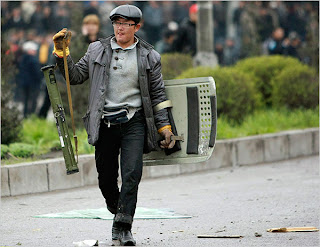Provoking Thought: Punchlines
You want to hear a joke?
Why do Polish airplanes fly so low?
So the pilots can read the street signs.
So the joke was lame. But it becomes much funnier when you put it in a different context. Let's just say that the latest news out of Moscow and Warsaw aren't going to help out the stereotypes of Polish people.
Update - one of my buddies, as his Facebook status: is mowing his driveway in honor of the King of Poland dying yesterday.
Notable excerpts from the New York Times article:
Officials in Poland have repeatedly requested that the government’s aging air fleet be replaced...
...Russian air traffic controllers advised the crew to land in Minsk, but the crew decided to land anyway...
...Russian media reported that the airplane’s crew made several attempts to land before a wing hit the treetops and the plane crashed about half a mile from the runway.
I mean, this can't be good, right?
The notion of a stereotype is interesting to me. Not so much in the way that we use it in common language, or the way that sociologists use it. That's sort of a boring, superficial way to look at an outcome. However, looking at the process of why we stereotype, a more psychological approach, is what I prefer.
Basically, a stereotype is a heuristic (or simple decision rule) that people tend to use, largely because the placing of things into categories is one of the ways to simplify information. Basically, we don't have the capacity to constantly evaluate everything on it's own merits, from scratch. So we bring in information from our previous experiences and knowledge. This helps us make sense of the world around us. Now for something to take hold as a stereotype, there have to be roots in "truth" (we'll get to the quotation marks in a bit). And one argument for stereotypes being helpful to us is that if the things that we see in the world around us consistently run counter to the stereotypes that we hold, then the stereotypes are no longer useful, thus the stereotypes that we have must be consistent with the things that we see.
I particularly like nation-of-origin stereotypes. For example, the stereotype that Yugoslavian automobiles are terrible and may explode on contact may have no basis in fact, but it's what I believe. Similarly, the notion that all Swedish women are 6' tall, buxom blondes who do acrobatic feats on water skis while wearing skimpy bikinis is also a fact in my mind (though this one may be true - we will probably have to look at this more closely). However, stereotypes based on gender and sexual orientation are amusing to me, as well. Actually, as I think about it, I enjoy stereotypes of all sorts.
Now with regard to this notion of what we believe to be "true," we also carry a bias toward ourselves, since everyone thinks they're awesome, or at least better than they actually are. Part of this is because how we judge information is flawed. We don't treat information symmetrically, and I'm going to oversimplify the explanation. Positive and negative things are judged differently. Negative things stand out to us. People who study the effects of word-of-mouth on businesses say that it takes 6 or 7 pieces of good word-of-mouth to overcome one negative piece of word-of-mouth. So, if you believe that black people are criminals, even if you're surrounded by black people with MBAs, PhDs, JDs and MDs, if you see a black guy shoplift from a Wal-Mart, then you're probably going to continue with that belief. Think back to the early interaction between Gene Hackman and Chris O'Donnell in The Chamber, a movie based on the Grisham novel, where Hackman chides O'Donnell for his liberal sensibilities, and notes that when push comes to shove, the dark imagery that come about from stereotypes emerge.
And to be fair, if you buy into evolutionary arguments, these stereotypes emerge as an "avoidance" behavior, where we avoid things that are unfamiliar and dangerous, overestimating the risk and costs involved. Basically, a Type I error (where we have a false alarm) is something that keeps us alive. On the other hand, a Type II error (where we don't detect a threat) is something that makes us dead. So, we're conditioned to avoid unfamiliar situations and to be afraid of unfamiliar people. From this perspective, stereotypes serve a purpose, as well.
As far as overcoming stereotypes, the basic formula is time and effort. We know that 1 negative thing poisons our thoughts, even against the backdrop of generally positive things. So, if we, as a whole, care about changing stereotypes, the onus really has to fall on those who perpetuate the stereotypes. This includes both those who are being stereotyped, as well as those who pass on the stereotypes to others. For example, if I was worried about ending the stereotype that Polacks are dumb, I probably wouldn't have opened up things here with the Polack joke, or posted that NYT article.
Happily, I don't have that burden, and can simply enjoy laughing at the absurd, like I always do.
-Chairman











